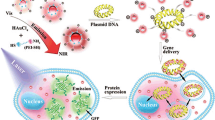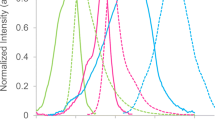Abstract
Nanoparticles have enormous potential for bioimaging and biolabeling applications, in which conventional organically based fluorescent labels degrade and fail to provide long-term tracking. Thus, the development of approaches to make fluorescent probes water soluble and label cells efficient is desirable for most biological applications. Here, we report on the fabrication and characterization of self-assembled nanodots (SANDs) from 3-aminopropyltriethoxysilane (APTES) as a probe for protein labeling. We show that fluorescent SAND probes exhibit both bright photoluminescence and biocompatibility in an aqueous environment. Selective in vitro imaging using protein and carbohydrate labeling of hepatoma cell lines are demonstrated using biocompatible SANDs conjugated with avidin and galactose, respectively. Cytotoxicity tests show that conjugated SAND particles have negligible effects on cell proliferation. Unlike other synthetic systems that require multistep treatments to achieve robust surface functionalization and to develop flexible bioconjugation strategies, our results demonstrate the versatility of this one-step SAND fabrication method for creating multicolor fluorescent probes with the tailored functionalities, efficient emission, as well as excellent biocompatibility, required for broad biological use.

Similar content being viewed by others
References
Bailey, R. E.; Smith, A. M.; Nie, S. M. Quantum dots in biology and medicine. Physica E 2004, 25, 1–12.
Jaiswal, J. K.; Goldman, E. R.; Mattoussi, H.; Simon, S. M. Use of quantum dots for live cell imaging. Nat. Methods 2004, 1, 73–78.
Resch-Genger, U.; Grabolle, M.; Cavaliere-Jaricot, S.; Nitschke, R.; Nann, T. Quantum dots versus organic dyes as fluorescent labels. Nat. Methods 2008, 5, 763–775.
Michalet, X.; Pinaud, F. F.; Bentolila, L. A.; Tsay, J. M.; Doose, S.; Li, J. J.; Sundaresan, G.; Wu, A. M.; Gambhir, S. S.; Weiss, S. Quantum dots for live cells, in vivo imaging, and diagnostics. Science 2005, 307, 538–544.
Smith, A. M.; Dave, S.; Nie, S. M.; True, L.; Gao, X. H. Multicolor quantum dots for molecular diagnostics of cancer. Expert Rev. Mol. Diagn. 2006, 6, 231–244.
Selvan, S. T.; Tan, T. T. Y.; Yi, D. K.; Jana, N. R. Functional and multifunctional nanoparticles for bioimaging and biosensing. Langmuir 2010, 26, 11631–11641.
King-Heiden, T. C.; Wiecinski, P. N.; Mangham, A. N.; Metz, K. M.; Nesbit, D.; Pedersen, J. A.; Hamers, R. J.; Heideman, W.; Peterson, R. E. Quantum dot nanotoxicity assessment using the zebrafish embryo. Environ. Sci. Technol. 2009, 43, 1605–1611.
Lin, P.-Y.; Hsieh, C.-W.; Kung, M.-L.; Hsieh, S. Substrate-free self-assembled SiOx-core nanodots from alkylalkoxysilane as a multicolor photoluminescence source for intravital imaging. Sci. Rep. 2013, 3, 1703.
Sun, X. P.; Wei, W. T. Electrostatic-assembly-driven formation of micrometer-scale supramolecular sheets of (3-aminopropyl)triethoxysilane(APTES)-HAuCl4 and their subsequent transformation into stable APTES bilayer-capped gold nanoparticles through a thermal process. Langmuir 2010, 26, 6133–6135.
Chai, C.; Lee, J.; Takhistov, P. Direct detection of the biological toxin in acidic environment by electrochemical impedimetric immunosensor. Sensors 2010, 10, 11414–11427.
Faucheux, N.; Schweiss, R.; Lützow, K.; Werner, C.; Groth, T. Self-assembled monolayers with different terminating groups as model substrates for cell adhesion studies. Biomaterials 2004, 25, 2721–2730.
Smith, P. K.; Krohn, R. I.; Hermanson, G. T.; Mallia, A. K.; Gartner, F. H.; Provenzano, M. D.; Fujimoto, E. K.; Goeke, N. M.; Olson, B. J.; Klenk, D. C. Measurement of protein using bicinchoninic acid. Anal. Biochem. 1985, 150, 76–85.
Dubois, M.; Gilles, K. A.; Hamilton, J. K.; Rebers, P. A.; Smith, F. Colorimetric method for determination of sugars and related substances. Anal. Chem. 1956, 28, 350–356.
Aissaoui, N.; Bergaoui, L.; Landoulsi, J.; Lambert, J.-F.; Boujday, S. Silane layers on silicon surfaces: Mechanism of interaction, stability, and influence on protein adsorption. Langmuir 2012, 28, 656–665.
Llewellyn, N. M.; Spencer, J. B. Chemoenzymatic acylation of aminoglycoside antibiotics. Chem. Commun. 2008, 32, 3786–3788.
Gerion, D.; Pinaud, F.; Williams, S. C.; Parak, W. J.; Zanchet, D.; Weiss, S.; Alivisatos, A. P. Synthesis and properties of biocompatible water-soluble silica-coated CdSe/ZnS semiconductor quantum dots. J. Phys. Chem. B 2001, 105, 8861–8871.
Pellegrino, T.; Manna, L.; Kudera, S.; Liedl, T.; Koktysh, D.; Rogach, A. L.; Keller, S.; Rädler, J.; Natile, G.; Parak, W. J. Hydrophobic nanocrystals coated with an amphiphilic polymer shell: A general route to water soluble nanocrystals. Nano Lett. 2004, 4, 703–707.
Chen, P.-C.; Chen, Y.-N.; Hsu, P.-C.; Shih, C.-C.; Chang, H.-T. Photoluminescent organosilane-functionalized carbon dots as temperature probes. Chem. Commun. 2013, 49, 1639–1641.
Wang, F.; Xie, Z.; Zhang, H.; Liu, C.-Y.; Zhang, Y.-G. Highly luminescent organosilane-functionalized carbon dots. Adv. Funct. Mater. 2011, 21, 1027–1031.
Cheang, T.-Y.; Tang, B.; Xu, A.-W.; Chang, G.-Q.; Hu, Z.-J.; He, W.-L.; Xing, Z.-H.; Xu, J.-B.; Wang, M.; Wang, S.-M. Promising plasmid DNA vector based on APTES-modified silica nanoparticles. Int. J. Nanomed. 2012, 7, 1061–1067.
Lu, G. H.; Mao, S.; Park, S. J.; Ruoff, R. S.; Chen, J. H. Facile, noncovalent decoration of graphene oxide sheets with nanocrystals. Nano Res. 2009, 2, 192–200.
Kim, J.; Seidler, P.; Wan, L. S.; Fill, C. Formation, structure, and reactivity of amino-terminated organic films on silicon substrates. J. Colloid Interf. Sci. 2009, 329, 114–119.
Evans, D. The systematic identification of organic compounds. J. Chem. Educ. 1999, 76, 1069.
Bistričić, L.; Volovšek, V.; Dananić, V. Conformational and vibrational analysis of gamma-aminopropyltriethoxysilane. J. Mol. Struct. 2007, 834-836, 355–363.
Vandenberg, E. T.; Bertilsson, L.; Liedberg, B.; Uvdal, K.; Erlandsson, R.; Elwing, H.; Lundstrom, I. Structure of 3-aminopropyl triethoxy silane on silicon-oxide. J. Colloid Interf. Sci. 1991, 147, 103–118.
Léandri, C.; Oughaddou, H.; Aufray, B.; Gay, J. M.; Le Lay, G.; Ranguis, A.; Garreau, Y. Growth of Si nanostructures on Ag(001). Surf. Sci. 2007, 601, 262–267.
Seah, M. P.; Gilmore, I. S.; Spencer, S. J. Quantitative XPS: I. Analysis of X-ray photoelectron intensities from elemental data in a digital photoelectron database. J. Electron Spectrosc. 2001, 120, 93–111.
Sharma, P.; Brown, S.; Walter, G.; Santra, S.; Moudgil, B. Nanoparticles for bioimaging. Adv. Colloid Interfac. 2006, 123–126, 471–485.
Eck, W.; Nicholson, A. I.; Zentgraf, H.; Semmler, W.; Bartling, S. Anti-CD4-targeted gold nanoparticles induce specific contrast enhancement of peripheral lymph nodes in X-ray computed tomography of live mice. Nano Lett. 2010, 10, 2318–2322.
Zhuo, Y.; Chai, Y.-Q.; Yuan, R.; Mao, L.; Yuan, Y.-L.; Han, J. Glucose oxidase and ferrocene labels immobilized at Au/TiO2 nanocomposites with high load amount and activity for sensitive immunoelectrochemical measurement of ProGRP biomarker. Biosens. Bioelectron. 2011, 26, 3838–3844.
Qiao, Z.-A.; Wang, Y. F.; Gao, Y.; Li, H. W.; Dai, T. Y.; Liu, Y. L.; Huo, Q. S. Commercially activated carbon as the source for producing multicolor photoluminescent carbon dots by chemical oxidation. Chem. Commun. 2010, 46, 8812–8814.
Li, Y.; Hu, Y.; Zhao, Y.; Shi, G. Q.; Deng, L.; Hou, Y. B. Qu, L. T. An electrochemical avenue to green-luminescent graphene quantum dots as potential electron-acceptors for photovoltaics. Adv. Mater. 2011, 23, 776–780.
Liu, R. L.; Wu, D. Q.; Liu, S. H.; Koynov, K.; Knoll, W.; Li, Q. An aqueous route to multicolor photoluminescent carbon dots using silica spheres as carriers. Angew. Chem. Int. Ed. 2009, 48, 4598–4601.
Sun, Y.-P.; Zhou, B.; Lin, Y.; Wang, W.; Fernando, K. A. S.; Pathak, P.; Meziani, M. J.; Harruff, B. A.; Wang, X.; Wang, H. F., et al. Quantum-sized carbon dots for bright and colorful photoluminescence. J. Am. Chem. Soc. 2006, 128, 7756–7757.
Liu, H. P.; Ye, T. Mao, C. D. Fluorescent carbon nanoparticles derived from candle soot. Angew. Chem. Int. Ed. 2007, 46, 6473–6475.
Doherty, G. J.; McMahon, H. T. Mechanisms of endocytosis. Annu. Rev. Biochem. 2009, 78, 857–902.
Hillaireau, H.; Couvreur, P. Nanocarriers’ entry into the cell: Relevance to drug delivery. Cell. Mol. Life Sci. 2009, 66, 2873–2896.
Perumal, O. P.; Inapagolla, R.; Kannan, S.; Kannan, R. M. The effect of surface functionality on cellular trafficking of dendrimers. Biomaterials 2008, 29, 3469–3476.
Liu, T.; Wang, S.; Chen, G. Immobilization of trypsin on silica-coated fiberglass core in microchip for highly efficient proteolysis. Talanta 2009, 77, 1767–1773.
Jang, L.-S.; Liu, H.-J. Fabrication of protein chips based on 3-aminopropyltriethoxysilane as a monolayer. Biomed. Microdevices 2009, 11, 331–338.
Zhong, Z. Y.; Shan, J. L.; Zhang, Z. M.; Qing, Y.; Wang, D. The signal-enhanced label-free immunosensor based on assembly of prussian blue-SiO2 nanocomposite for amperometric measurement of neuron-specific enolase. Electroanalysis 2010, 22, 2569–2575.
Chuang, Y.-H.; Chang, Y.-T.; Liu, K.-L.; Chang, H.-Y.; Yew, T.-R. Electrical impedimetric biosensors for liver function detection. Biosens. Bioelectron. 2011, 28, 368–372.
Livnah, O.; Bayer, E. A.; Wilchek, M.; Sussman, J. L. Three-dimensional structures of avidin and the avidinbiotin complex. Proc. Natl. Acad. Sci. USA. 1993, 90, 5076–5080.
Hiller, Y.; Gershoni, J. M.; Bayer, E. A.; Wilchek, M. Biotin binding to avidin. Oligosaccharide side chain not required for ligand association. Biochem. J. 1987, 248, 167–171.
Said, H. M.; Ma, T. Y.; Kamanna, V. S. Uptake of biotin by human hepatoma cell line, Hep G2: A carrier-mediated process similar to that of normal liver. J. Cell. Physiol. 1994, 161, 483–489.
Zempleni, J.; Mock, D. M. Biotin biochemistry and human requirements. J. Nutr. Biochem. 1999, 10, 128–138.
Wang, Y.-C.; Liu, X.-Q.; Sun, T.-M.; Xiong, M.-H.; Wang, J. Functionalized micelles from block copolymer of polyphosphoester and poly(ɛ-caprolactone) for receptor-mediated drug delivery. J. Control. Release 2008, 128, 32–40.
David, S.; Passirani, C.; Carmoy, N.; Morille, M.; Mevel, M.; Chatin, B.; Benoit, J.-P.; Montier, T.; Pitard, B. DNA nanocarriers for systemic administration: Characterization and in vivo bioimaging in healthy mice. Mol. Ther. Nucleic Acids 2013, 2, e64.
Nagabhushan, T. L.; Cooper, A. B.; Turner, W. N.; Tsai, H.; McCombie, S.; Mallams, A. K.; Rane, D.; Wright, J. J.; Reichert, P. Interaction of vicinal and nonvicinal aminohydroxy group pairs in aminoglycoside-aminocyclitol antibiotics with transition metal cations. Selective N protection. J. Am. Chem. Soc. 1978, 100, 5253–5254.
Basiruddin, S. K.; Ranjan Maity, A.; Jana, N. R. Glucose/galactose/dextran-functionalized quantum dots, iron oxide and doped semiconductor nanoparticles with <100 nm hydrodynamic diameter. RSC Adv. 2012, 2, 11915–11921.
Khorev, O.; Stokmaier, D.; Schwardt, O.; Cutting, B.; Ernst, B. Trivalent, Gal/GalNAc-containing ligands designed for the asialoglycoprotein receptor. Biorgan. Med. Chem. 2008, 16, 5216–5231.
Author information
Authors and Affiliations
Corresponding author
Electronic supplementary material
Rights and permissions
About this article
Cite this article
Kung, ML., Lin, PY., Hsieh, CW. et al. Aqueous self-assembly and surface-functionalized nanodots for live cell imaging and labeling. Nano Res. 7, 1164–1176 (2014). https://doi.org/10.1007/s12274-014-0479-y
Received:
Revised:
Accepted:
Published:
Issue Date:
DOI: https://doi.org/10.1007/s12274-014-0479-y




